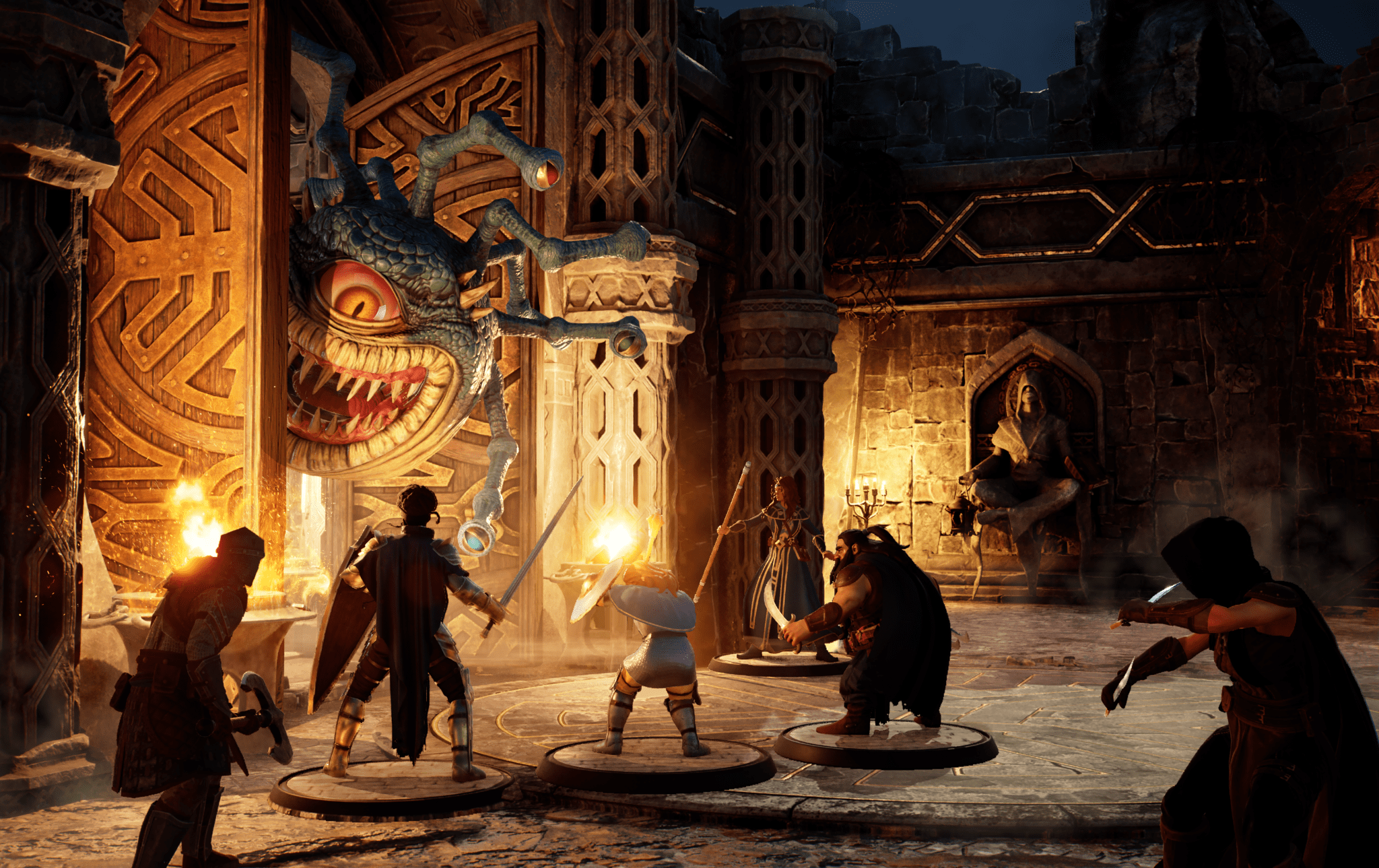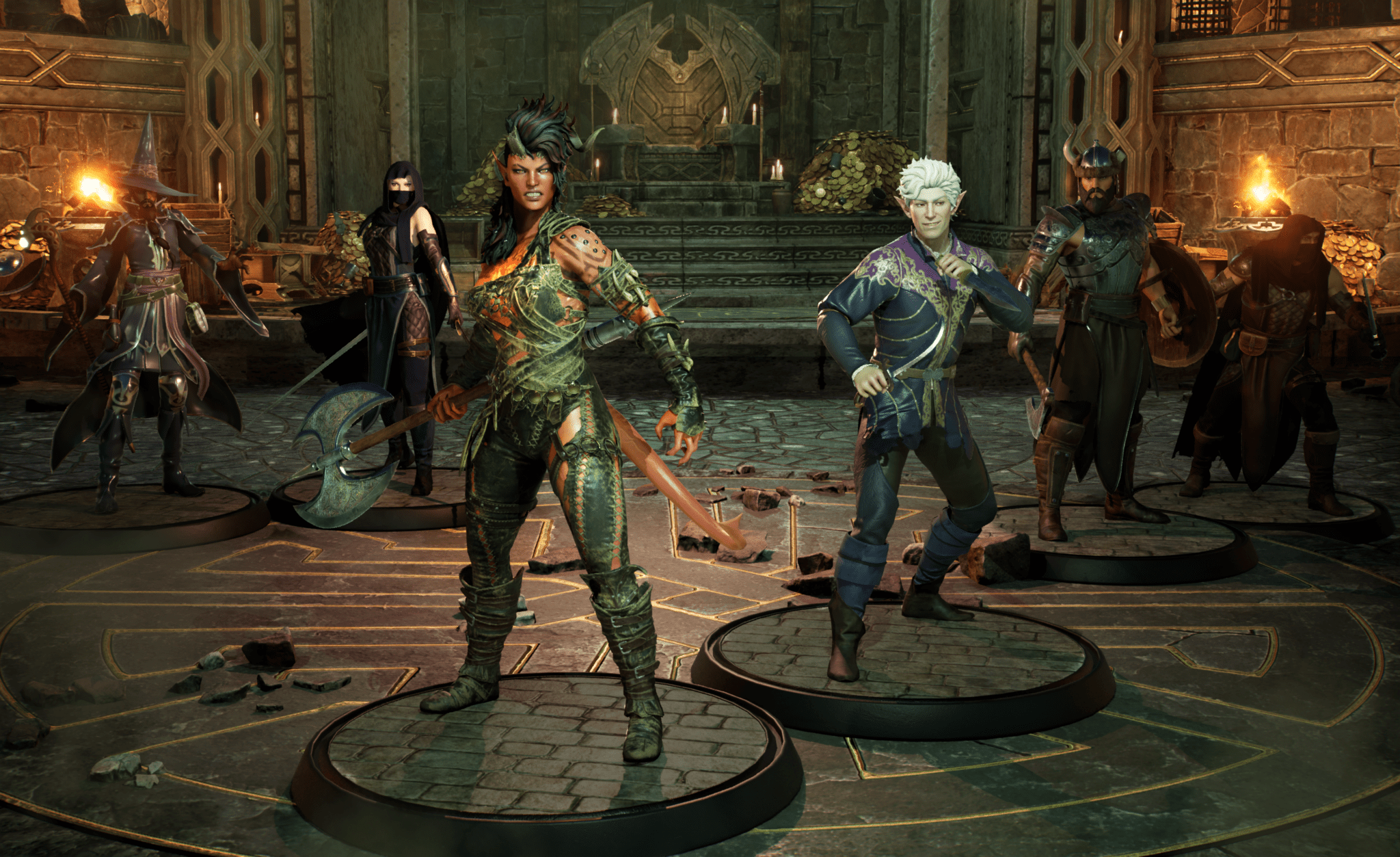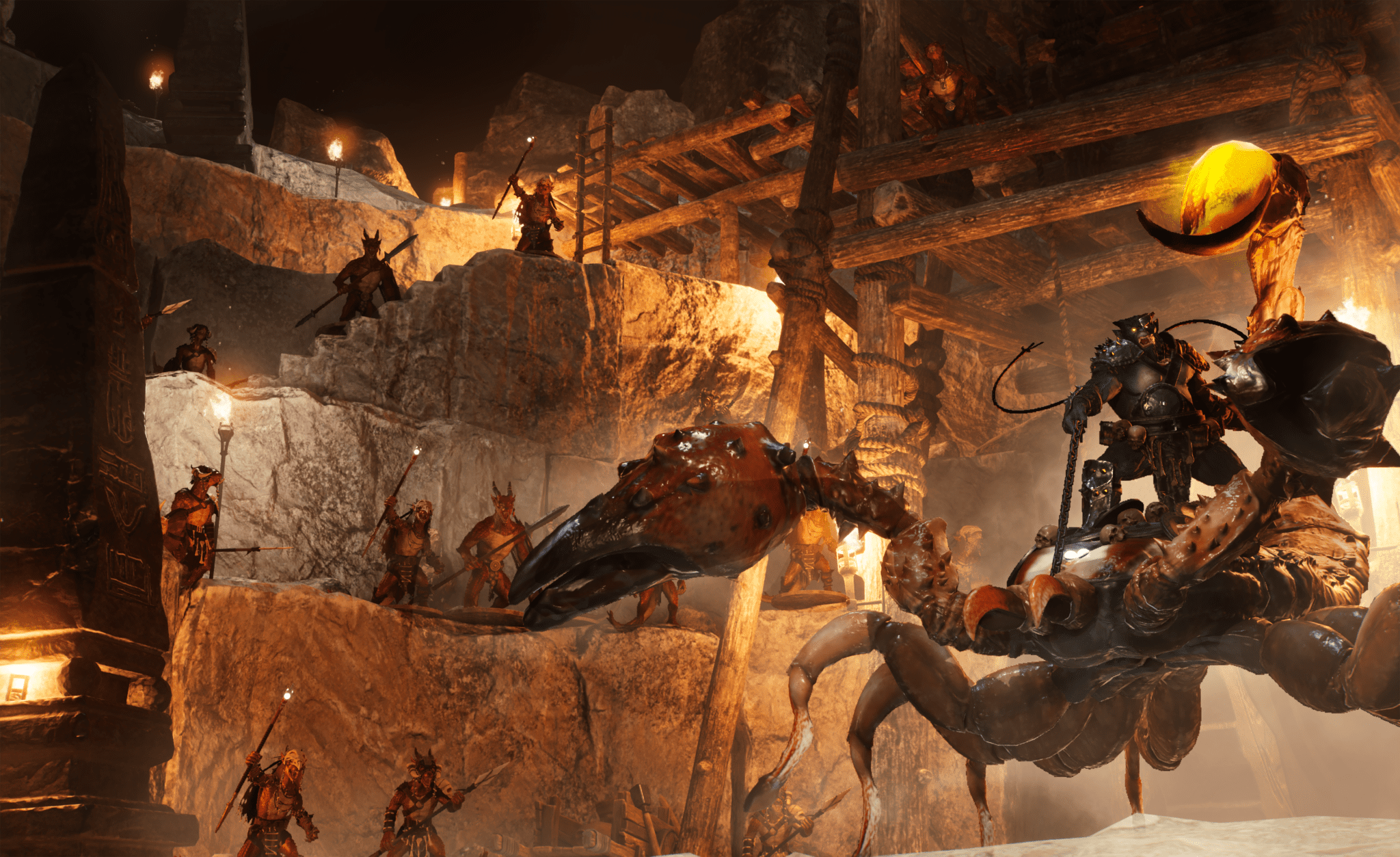As part of the Dungeons & Dragons 50th Anniversary, Wizards of the Coast has been making big changes to their biggest brand with new brand deals, new rulebooks, and more. But no D&D topic has been as heated and mysterious as Project Sigil, the company’s big entry into the crowded VTT space. At Gen Con, we got an early look at the Unreal Engine 5-based tool as well as got to see how combat and level design works in-game. We also sat down with Vice President Digital Game Development Chris Cao and Dungeons & Dragons Digital Director Kale Stutzman to learn more about the game(?)’s development process and what the company’s expectations are for the ambitious project.
We’re 10 years into 5E, and part of that 5E development has been having more digital options. There are so many existing Virtual Tabletops (VTT). I’m curious what the process has been in thinking about what is and what you’re doing to stand out and make it so it’s going to be something that’s going to be essential to place.
Chris Cao: How do we fit in, and what do we do? I think first off, I just have to give a shout out to all of the fans who basically built what we hadn’t yet. Roll20, Foundry, Fantasy Grounds, Owlbear Rodeo. I wanted to start there because D&D Beyond works with all of these other sites, that’s where they came from, so for us, all they were doing is saying, “Hey, I want to play D&D with my friends remotely, or I want to make it easier to play D&D.” Us being part of this ecosystem, books and web, and now Project Sigil, really D&D Beyond maps are more like your classic VTT, because it’s 2D, it’s on the web, which means anybody can use it anywhere. It’s meant to be that thing. That’s a very strong compliment to the books. The text is in there, all the rest of it.
When we originally were talking about Sigil, I kept asking Kale through PowerPoint, how close is this? What is this? We were trying to figure out, and what we actually came to was, we know we can’t be a transliteration of the books, because it takes us too long to build a castle. Perkins can say “The Dark Castle” in a sentence. It takes us six months to make the Dark Castle. We said, “Why don’t we revisit the idea of a module of a place where it’s like, “Hey, here’s a one or two hour, here’s a session or two, and then let’s give you the toys so that you can take them apart and remix them and do what you want.”

For us, it’s not in the simulation space or in the transliteration space, it’s in the immersive space, which is why not everyone’s using it all the time to play. They’ll play it for, especially, like combat or reveal of an area or that kind of thing. Then they’ll use all the other tools. We don’t stand alone. We’re part of this with Sigil and with the books.
Kale Stutzman: I think it can be used in that way as well, and I think that’s where a lot of the hardcore D&D audience is going to see it as like, Oh, it’s big boss time, let’s spend extra time to make it really cool, but I think the new players are going to come in and they’re going to be like, “Oh, I could just use this.”
Somebody who’s coming to this and they’ve just come from Baldur’s Gate 3, they may want that immersive experience all the time, but for them it might be about shorter modular sessions that they can play an hour at a time or two hours at a time and really get that D&D fix, and they don’t need the other stuff. It’s interesting, because I think it’s a bridge between.
Cao: It’s a little bit like how Critical Role plays. They play in person. They have the digital character sheets, and then Matt pulls out the minis. It’s that.
Stutzman: Dimension 20 works like that too.
Cao: Dimension 20. Yes.
Stutzman: It’s like if they’ll talk for a while and they’ll just have fun at the table, and then it’s like, bring out the stuff.
I’m curious about the the way that you’ve been thinking about that translation of “I just played Baldur’s Gate, I’m coming in as a gamer.” You guys have experience in other genres of video game and getting people who are coming from that side of it, particularly. I wonder how you thought about that more intentionally?

Cao: We’re thinking deeply about it, for sure.
Stutzman: They really need that because there’s a lot of non-D&D players at Wizards, right? Especially all over the company. We like to bring them in and sit them down and say, “Okay, start playing with us,” and see how that transition for them. Sometimes they play computer games, sometimes they don’t use computers or play D&D, and you say “Okay, there’s buttons at the bottom of the screen and they do things.”
Cao: The trickiest part actually is that, as D&D players, we often think, “Oh, we have to teach you the rules.” The rules aren’t a problem. The problem is, how do you remember that you get to play with your imagination? You come up with every action, you come up with what you say. What’s funny is video games skipped over that part. They went straight to the run around kill monsters part. We’re using the best game engineers to take it back a step to you’re just playing with a toy. For the video gamers that is actually the new novel thing, because it looks like a video game. It’s got video game controls, but they’re actually telling the story actively, not as a dialogue tree.
Stutzman: Then, it’s really fun to bring it to new people beecause you’ll have somebody, like, Cynthia [Williams] our old president. I think the first time she played, she played a Wizard, which you wouldn’t give to a first-time player. Wizard’s very complex, but she was like, “I want to try the wizard,” and then she clicked the fireball button and then blasted all these kobolds with a fireball. She said “I like being a wizard. Why didn’t you guys let me play Wizard last time?” [laughs]
Cao: She was playing in tabletop campaigns, and now she’s like, “I like to blow shit up.” She was going wild.
Stutzman: Exactly. Then it was when she played at tabletop the first time, I think they were like, “Oh, be a fighter,” because that’s the easiest one of the rules.
Cao: Which makes sense.
Stutzman: Which makes sense, but then when she had the–
Cao: When you have a character that you can move around, it just helps a lot. We also forget we have really powerful imaginations as D&D players, because we are hundreds of hours into imagining scenes. Do that if you want. Other people don’t have that precision. We still have a lot of room for imagination. We just give you things to look at to help you along.

If you think about accessibility, it’s used in two different ways in these scenarios. The one of them that we just talked about is the players, but I’m curious how you’ve worked to make Project SIGIL as testable for the people with visual impairment or colorblind. Are there tools in place for that or plans for making it more accessible?
Cao: Yes. We started early on with consulting with both, I don’t know, I’m not an expert, but physical disabilities as well as neuroatypical situations. We’ve had consultation there. In all honestly, we haven’t gone far enough yet because we’ve just key-rebinding in. We’re just at the start of it, but we want to do things like controller support because that often allows a lot of alternate peripherals to go in. Contrast controls those sorts of things. Really, this is get into closed beta in the form we can get it in to get the best feedback. We talked to the blind gamers, like, “Hey, how does this match up?” Some of it honestly doesn’t, but some of it, why not try? Let’s see.
I think Wizards has done a really good job with featuring, even just in the art and featuring more ability to be like, “Yes, here’s some options for if you’re someone who uses a wheelchair, or if your player character is visually impaired.”
Cao: We all know you’re expressing yourself or you’re trying out a new self. There’s a reason why at the tween stage, we all got into this because we’re like, “Who am I? What am I doing?” Being able to role play is a great way to explore.
My last question, and it’s going to be controversial topic, is about new assets monetization. How will people get new stuff? Will there be new creation options, or will there be constantly new things added by you that will then be on a marketplace?
Stutzman: Before you answer business-wise, let me answer the creatively first, which is every group, including my group that I play with every week, has one person who will never spend money on D&D, but we love that person. We want them at the table all the time. “That person has to be able to play.” They have to be able to play and not in a token way. In a way that they can play something that can continue to level up with everybody else.
Cao: I’m going to do the creative through business because the important thing is we sell as a business the empowerment for players to make their own stuff and to do their own stuff, right? We’re not the Photoshop of those types of games, right, but we are a game support system much like a Minecraft or Roblox where you can express yourself. First off, in the game, there will be 2D maps and tokens like flat tokens. You can just play. If you just want to play, if you want to play the starter set, it’s 3D so you get an idea of it. You can play that for free with your friends.

We want to make sure people stay connected. The subclasses and the choices that are there, you’ll be able to play for free with your friends and just keep going. Because we’re also client server, because we actually want to make high fidelity assets, we want to make a sustainable business out of it. We’re starting with the subscriptions because we know D&D players like them, we know we can add value to them and we know that the idea of saying you’re going to sign up and you’re going to get more access, but it makes sense and it’s the expectation we’ve already set. Now up there I also talked about, hey, I go to a game store and it’s unlike any other store. It’s this place where there’s miniatures out, there’s maps on the walls, there’s swords hanging, so it’s an experience. People like to spend money on all of that. If you want to spend money on that, we just want to find the best way for you to pay for that. That’s sustainable, that’s extensible and most importantly, that’s what you want.
Because sometimes you buy a product and you pay up front and then you get what do they want or sometimes folks sell you all the– they’ll dress up a slot machine as a microtransaction machine, right? Really, we’re just like, what do D&D players already like to buy, how do they like to buy it, but the key thing is, we don’t want to assume it so we want to have people play before we charge them, because we actually need the feedback and go more of this and less of that. It’s not going to be just like all up community feedback, because players will want something different than DMs and honestly there’s a whole another group out there, the dollhouse types, people who just like to build stuff and play stuff.
Stutzman: Hopefully folks understand if you take away anything. We’re being general on some of it, because if we say we’re going to do all of this and you haven’t played it, then that means we don’t actually know what you value. We know what you conceptually value and we know what we conceptually should charge you. That sounds like a mess [laughter]
Images via Wizards of the Coast
Have strong thoughts about this piece you need to share? Or maybe there’s something else on your mind you’re wanting to talk about with fellow Fandomentals? Head on over to our Community server to join in the conversation!

